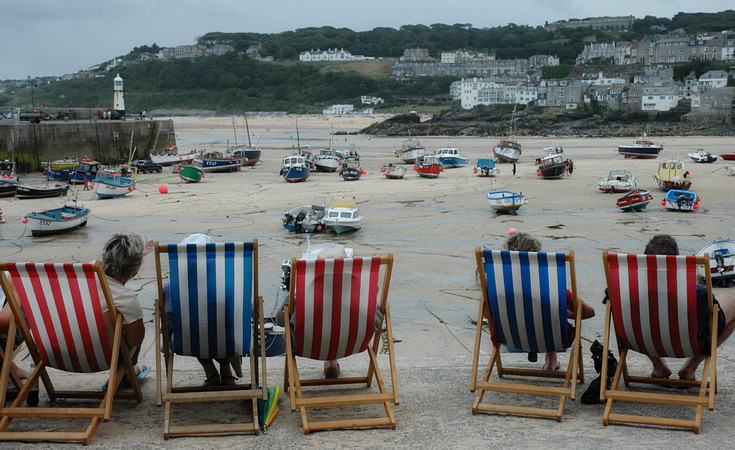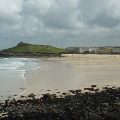
Here’s a set of photos taken around Cornwall and Devon some fifteen years ago, on the summer of 2005.
Above: deck chairs and St Ives harbour.
The view from the train as it hurtles along the seafront by Dawlish is spectacular.
Equally stunning is Brunel’s Royal Albert Bridge, which spans the River Tamar to link Plymouth in Devon with Saltash in Cornwall.
Its unique design consists of two 455-foot (138.7 m) lenticular iron trusses 100 feet (30.5 m) above the water, with conventional plate-girder approach spans., giving it a total length of 2,187.5 feet (666.8 m).
View from the bridge.
St Erth is easily one one of my favourite railway stations in the UK.
The Grade II listed station is situated on the London Paddington to Plymouth mainline and hosts the junction for the St Ives Bay Line to St Ives.
Rail traffic is still controlled by Victorian-era semaphore signalling, controlled by the 1899 signal box seen in the distance.
Find out more about the station in this detailed photo feature: St Erth railway station.
Old fashioned road sign.
St Ives bay.
Junior fishermen.
Taking in the view.
St Ives beach at dusk.
Sky and sand.
The road to Portreath, Cornwall.
Surfers galore, Porthmeor Beach.
King Canute, Cornwall style.
St Ives is a beautiful town but it can become horrendously busy in the holiday season.
Taking a dip.
Godrevy Lighthouse was built in 1858–1859 and stands on Godrevy Island in St Ives Bay.
Situated near the small village of Gwithian, the white lighthouse proved the inspiration for Virginia Woolf’s, ‘To The Lighthouse’ novel.
Built on a rocky island, the 86ft high octagonal tower is made of rubble stone bedded in mortar, and the lighthouse has been operating since March 1859, being automated in 1934.
Stunning beaches seen from the St Ives branch line train.
Portreath beach. The historical harbour of Portreath started life in 1760 as an outlet for the mining industry, with its ‘Welsh Fleet’ regularly exporting rich copper ore destined for the smelting furnaces of Swansea.
The ships then returned laden with Welsh coal for the steam-powered beam engines used in the local tin and copper mines.
Sadly, Portreath’s days of greatness are long over, and the village has returned to a quiet life with a splendid beach and a rather tatty offering of tourist facilities.
St Ives at high tide.
The St Ives museum was a lo-tech wonder.
The busy Sloop Inn which faces St Ives harbour.
Gravestones overlooking the sea at St Ives.
Accessible only at low tide, St Michael’s Mount is a former Benedictine Priory and Castle which was involved in both the Wars of the Roses and the Cornish Rebellion against Edward VI.
It’s now owned by the National Trust.
This Art Deco sea pool known as Jubilee Pool in Penzance originally opened in May 1935, the year of King George V’s Silver Jubilee.
Godrevy lighthouse through the mist.
The small chapel on St Ives Head.
Cycling across the Cornish moors as the mist dscends.
Old stone milepost near Zennor.
We took a sizeable rainy detour in a failed quest to find the famous Men-an-tol stones, near the old Ding Dong mine.
Windbreaks on a busy Porthminster Beach.
Save Our Fish, Newlyn. Illuminated at Christmas, this sign highlights the fears of the local community as over-fishing and EU Quotas have decimated Newlyn’s once thriving fishing industry.
Donations box for Mousehole’s Harbour Lights.
Taking its name from the small gap in the harbour wall that looks like a mouse hole, the small fishing village is pronounced, ‘Mowzel.’
Mousehole’s small harbour.
Harbour views.
Artist at work.
Something odd and Cornish going on here.
All alone on the beach.
Headless telescope.
Lifeboat takes to the sea.
The site of St Ives once-grand railway station.
Opened by the Great Western Railway on 1 June 1877 as the terminus of a 4.5 mile branch line from St Erth, the station once had double track and a long sweeping single platform that could accommodate two trains at the same time. It’s now a single track siding from St Erth, listed as one of the most picturesque railways in England.
See feature here: St Ives railway station: then and now

